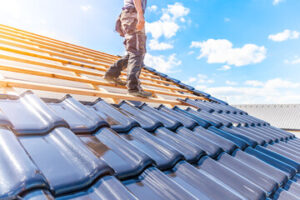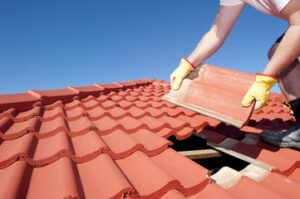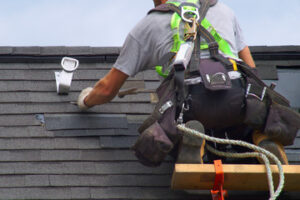Roof replacement is one of the most significant home renovations you can do. It protects your home and raises its value.

However, re-roofing isn’t always the best option. Depending on the material, roofing materials have a lifespan or “sell-by date.” Significant damage to a roof often requires a total roof replacement. Visit https://redstickroofing.com/lafayette to learn more.
When making any major purchase, cost is a big concern. Roof replacement is no exception. While the benefits of a new roof are clear, it’s also one of the most expensive home upgrades that homeowners can make. This is why it’s so important to research contractors and compare prices. However, don’t fall prey to the temptation of going with the first roofer that comes along. This can be a costly mistake. It’s recommended that you get a minimum of three quotes before selecting a contractor for your roof replacement.
The cost of a roof can vary widely, depending on the materials used and the size of your home. Prices are typically quoted per square foot, with some material options costing more than others. You’ll also need to consider labor costs, which can account for up to 60% of the total cost. This includes removing and disposing of the old roof and materials, as well as installing and cleaning up.
Other costs associated with roof replacement include gutters, venting, and soffit repairs. A soffit is the underside of the roof overhang, and it’s important to keep it clean and free of moisture to prevent water damage and other issues. It can be difficult to access, so you’ll likely need to hire a professional for soffit repairs or replacement. A soffit is usually made of metal and shaped like an “L,” and it’s responsible for directing water and air away from the roof. It can cost between $6 and $30 per linear foot to replace or repair.
Many counties require a building permit and inspection before beginning a roof project. This can add to the overall cost of your project, especially if you live in an urban area. In addition, some HOAs require permission before starting a roof replacement or repair.
Investing in a new roof will improve your home’s value and protect it from future damage. It can also increase your property tax base and lower your insurance premiums. In addition, a new roof can help reduce your energy bills by keeping your house cooler in the summer and warmer in the winter.
Materials
The roof is one of the most important parts of a home, protecting it from moisture and other environmental factors. The type of roofing materials used during a roof replacement project can impact its lifespan and curb appeal. In addition, the roof’s condition can affect a house’s overall value.
When choosing a new roof, homeowners should consider the desired lifespan of the roofing material, maintenance requirements, and cost. Additionally, they should consider the climate of their region and whether certain materials are better suited for specific conditions.
Besides shingles, there are several other materials that are required to complete a roof replacement. These include fascia, soffit, and plywood decking. While these structures do not receive direct rainfall, they are prone to damage from rain and sun exposure. They can also deteriorate due to rot, which can lead to leaks and other structural problems in the home. If the roofing contractor notices that these structures are deteriorating, they will replace them to prevent water leaks and other weather-related damage.
Another factor to consider when deciding on the best roofing material is the desired aesthetics of your home. For instance, wood shingles and shakes offer a rustic look that pairs well with historic-style homes. These materials are made from cedar, redwood, or pine and can be stained to match the style of your home. Wood shingles and shakes are more expensive than asphalt shingles but have a longer lifespan than the latter.
Other options for a new roof include ceramic, composite, and rubber tiles. They are affordable and durable, but they may not be suitable for all climates. In addition, these materials do not withstand hail and other extreme weather conditions.
Lastly, the roof’s flashing and gutters must be replaced or repaired to protect it from water leaks. The flashing is located around the chimney and where the roofing planes meet. In addition, the gutters need to be cleaned regularly to prevent clogs. If the gutters are clogged, it can cause water to seep into the home’s interior.
When selecting a roofing material, homeowners should consider the warranty offered by the manufacturer. Typically, warranties cover workmanship and materials for a period of 10 to 30 years. During the selection process, homeowners should ask about the length of the warranty and what it covers. Ideally, the contract should include both a workmanship and material service contract.
Installation
Your roof is one of the most important parts of your home. It protects you and your family from rain, snow, sun, and other extreme weather conditions. It is also responsible for keeping your house a comfortable temperature throughout the year. If you have a damaged or old roof, it is time to consider a replacement. However, the roof installation process is complicated, and it requires professional assistance.
Before your roofing contractors start work, they will make sure that everything is ready for the new roof. They will sweep the roof, remove any debris from around the property and dispose of it. They will also move any outdoor objects that might be in the way, such as potted plants or ceramic landscaping features. They will also need to cut back trees that are encroaching on the roof, and they will set up tarps to protect your lawn and driveway from any falling debris.
Once the tarps are in place, the roofing contractors will begin to prepare the roof for the new material. This will include removing any rotting wood and cleaning the surface of the roof decking. They will also remove any existing shingles or tiles and prepare them for new ones. They will also replace any rotted or damaged flashing, such as the rubber or lead boots that are located on sanitary stacks and other vents. The roofer will also install metal flashing along chimneys and projections, in valleys, on hip roofs, and near any other leak-prone areas of your roof. The contractor will use a special bead of roofing cement to seal these areas and help prevent water leaks.
The roofing experts at Brothers will also install any needed roof vents to increase the airflow in your attic and improve your energy efficiency. They will also add new vent holes to your eaves, and they will install drip edge along the edges of the roof. The last step is to install the ridge cap on the top of your roof. This is the final step of your roof replacement, and it will be inspected to ensure that it meets all city codes.
Warranty
Roofing warranties are essential for homeowners to have, providing a safeguard against unforeseen costs and defects that could jeopardize the functionality of their roofs. However, there are a few important details about these warranties that homeowners should be aware of in order to fully benefit from them.
Warranty Coverage
It’s important to know the terms of your roofing warranty, as these can vary widely depending on the contractor and manufacturer. For example, a manufacturer’s roofing material warranty typically provides a lifetime coverage against manufacturing defects, while workmanship warranties are usually capped at 10 years or less. Additionally, some manufacturers offer additional warranty options, such as wind and algae warranties, that can extend the lifetime of a roof beyond the standard 10 year mark.
Workmanship and Material Warranties
A key aspect of a quality roofing system is the workmanship and material warranties that come with it. Most roofing contractors offer a warranty of at least one to two years, while installation and contractor warranties can last up to 50 years. These warranties ensure that a homeowner’s investment is protected and provide peace of mind that the contractor has stood behind their work.
Workmanship and material warranties differ, but most include provisions that require the homeowner to have regular inspections in order to maintain their coverage. Failure to keep up with these inspections, or hiring a different contractor for repairs, can void these warranties, so it’s important to follow the instructions carefully in order to enjoy the full protection of your roofing system.
Some manufacturers also have “Total System Warranties” that provide a full replacement for the entire roofing system if any of the components fail, such as flashings, insulation, and shingles. These are typically only offered to those who install a complete roofing system from that manufacturer, and are meant to provide a high level of confidence for homeowners.
Lastly, it’s important to note that most manufactures will not honor warranties unless they are registered, so it’s vital for homeowners to do this as soon as possible. In addition, some warranties are only transferable once, so it’s important for homeowners to inform their roofers and the manufacturer of any changes in ownership in order to avoid having their warranties voided.

